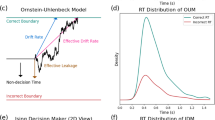Abstract
The objective of this article is to test a prediction of the quasi-hyperbolic model. The test is innovative in that it uses an experimental implementation in which there are two treatments: a forward market and a spot market. In each of these markets goods and activities are sold. The good and activities sold are investment goods or activities and temptation goods or activities. The prediction of the quasi-hyperbolic model is that in the spot (forward) market participants will buy more temptation (investment) goods and activities than in the forward market and less investment (temptation) good and activities. This prediction is not confirmed by the data, and hence is at odds with previous experiments which have shown support for the hyperbolic model. We speculate on the reasons for this.
Similar content being viewed by others
References
Carbone E. (2006) Understanding intertemporal choices. Applied Economics 38(8): 889–898
Harrison G.W., Lau M.I., Melonie W.B. (2002) Estimating individual discount rates in dennmark: a field experiment. The American Economic Review 92(5): 1606–1617
Laibson D. (1997) Golden eggs and hyperbolic discounting. The Quarterly Journal of Economics 112(2): 443–477
Phelps E.S., Pollak R.A. (1968) On second-best national saving and game-equilibrium growth. Review of Economic Studies 35(2): 165–180
Read D., Van Leeuwen B. (1998) Predicting hunger: the effects of appetite and delay on choice. Organizational Behavior and Human Decision Processes 76(2): 189–205
Read D., Loewenstein G., Kalyanaraman S. (1999) Mixing virtue and vice: combining the immediacy effect and the diversification heuristic. Journal of Behavioral Decision Making 12(4): 257–273
Author information
Authors and Affiliations
Corresponding author
Rights and permissions
About this article
Cite this article
Carbone, E. Temptations and Dynamic Consistency. Theor Decis 64, 229–248 (2008). https://doi.org/10.1007/s11238-007-9068-9
Received:
Accepted:
Published:
Issue Date:
DOI: https://doi.org/10.1007/s11238-007-9068-9




